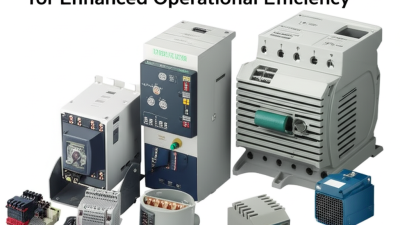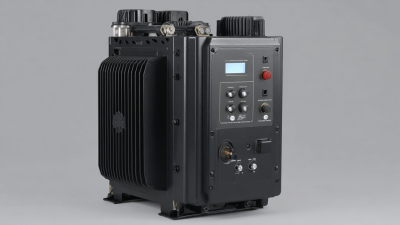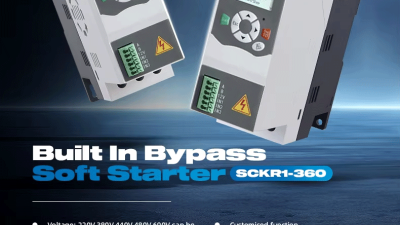Unveiling the Advantages of Soft Starters in 50Hz and 60Hz Applications for Enhanced Operational Efficiency
Table of Contents
- Understanding Soft Starters: Definition and Functionality in Motor Control
- The Role of Soft Starters in 50Hz vs. 60Hz Applications: A Comparative Analysis
- Key Benefits of Using Soft Starters for Energy Efficiency and Load Management
- Impact on Equipment Longevity: How Soft Starters Reduce Wear and Tear
- Installation and Maintenance Considerations for Optimal Performance
- Real-World Case Studies: Success Stories of Soft Starters in Industry Applications
- Revolutionizing Motor Control: The Advantages of Built-in Bypass Type Intelligent Motor Soft Starters
- FAQS
- Conclusion
- Related Posts
When it comes to industrial automation, making sure equipment runs smoothly and reliably is a big deal—especially when you think about power supply frequencies like 50Hz and 60Hz. Using soft starters that are compatible with these frequencies has really turned out to be a game changer for many companies. They help boost operational efficiency and also cut down on the wear and tear of machinery. Over at Zhejiang Chuanken Electric Co., Ltd., we've been in the game for 15 years, focusing on the research, development, manufacturing, and sales of industrial automation control products. We totally get how important these devices are for modern setups.

Soft starters work by reducing the electrical and mechanical stress that happens when motors start up, which means better performance and longer-lasting equipment. In this article, I’ll walk you through why adding soft starters can make such a difference in both 50Hz and 60Hz environments, and how they can really improve how things run in various industrial settings.
Understanding Soft Starters: Definition and Functionality in Motor Control
You know, soft starters are pretty essential when it comes to controlling motors. Basically, they help by gradually ramping up the voltage when you’re starting up a motor—think of it like easing into a hot bath rather than jumping right in. This slow build-up cuts down on that huge rush of current that can sometimes happen, which in turn prevents unnecessary stress on both the motor itself and the stuff connected to it. Whether you're dealing with 50Hz or 60Hz setups, soft starters make your motors run smoother and more efficiently—they help save energy and reduce wear and tear over time. By stopping those sudden power surges, they don’t just protect your gear—they actually help your whole system last longer.
Plus, soft starters come with some handy features like overload protection and adjustable acceleration times. That means you can tweak how quickly the motor ramps up depending on what you need—that’s a real lifesaver, especially in demanding industrial environments with heavy-duty motors. Adding soft starters into the mix can boost your operational efficiency, cut down on maintenance costs, and keep things running more smoothly overall. Honestly, they’ve become pretty much a must-have in modern motor control setups.
Unveiling the Advantages of Soft Starters in 50Hz and 60Hz Applications for Enhanced Operational Efficiency
| Aspect | 50Hz Applications | 60Hz Applications |
|---|---|---|
| Starting Current Reduction | Up to 50% reduction | Up to 60% reduction |
| Motor Protection | Prevents overheating | Prevents mechanical stress |
| Energy Efficiency | Improves efficiency by 10-30% | Improves efficiency by 15-35% |
| Operational Lifespan | Extends lifespan by 20% | Extends lifespan by 25% |
| Control Flexibility | Variable speed control | Smooth acceleration control |
| Noise Level | Lower operating noise | Further noise reduction |
The Role of Soft Starters in 50Hz vs. 60Hz Applications: A Comparative Analysis
When it comes to industrial setups, you’d notice that soft starters don’t always perform the same in 50Hz versus 60Hz systems. But overall, these devices — which gently ramp up motor speeds — definitely offer some pretty important benefits no matter where you are. For example, a report from the International Electrotechnical Commission (IEC) points out that using soft starters in a 50Hz environment can cut voltage peaks during startup by up to half. That’s a big deal because it reduces stress on electrical parts, essentially helping your equipment last longer. This is especially handy in places where heavy machinery has lots of starts and stops.
On the flip side, in 60Hz systems, the benefits of soft starters can be even more noticeable. According to the National Electrical Manufacturers Association (NEMA), motors running at 60Hz usually operate at higher power levels, which means starting shocks and wear and tear can be a real concern. Installing soft starters here can cut down the starting current by around 60%, which means less energy used during startup — saving you on power bills. Plus, it leads to smoother operation overall, making things run more efficiently and boosting productivity in the long run.
Key Benefits of Using Soft Starters for Energy Efficiency and Load Management
Soft starters are pretty much a must-have in industrial setups these days, especially when you're dealing with environments running at 50Hz or 60Hz. One of the best bits about using soft starters is how they help save energy. Instead of jolting the motor into action with a huge spike of current, they gently ramp up the voltage. That means fewer energy surges and, in the long run, lower operational costs. Honestly, investing in them is a smart move for any business that's serious about cutting down on energy waste.
Plus, soft starters do a great job when it comes to managing loads smoothly. They help reduce the mechanical stress on motors—think of it as giving your equipment a gentle wake-up instead of a rough start. This way, you get a longer lifespan for your gear and spend less on maintenance. They also help prevent those damaging sudden starts and stops, making your system more reliable overall. This controlled way of running things is especially handy if your operations involve frequent load changes. All in all, soft starters really tick both boxes: saving energy and keeping your equipment happy and healthy. That’s why they’re pretty much essential for modern industry!
Impact on Equipment Longevity: How Soft Starters Reduce Wear and Tear
You know, soft starters are really gaining recognition these days for how much they can boost operational efficiency across a bunch of different setups—especially in those 50Hz and 60Hz environments we often see. What’s cool about them is that they help reduce the mechanical stress right at the start when motors kick on. That means no more sudden jolts that can cause wear and tear over time, which is a big plus. Because of that, motors tend to last longer, and other parts like belts, couplings, and gears stay in good shape for much longer too.
Honestly, the impact of soft starters on extending equipment life is pretty significant. As industries get more serious about sustainability and cutting costs, minimizing machinery wear and tear is more important than ever—it helps slash maintenance expenses and lessens downtime. Did you know that recent reports are pointing to a pretty impressive growth in the soft starter market? It’s expected to hit around USD 14.49 billion by 2034, growing at nearly 10% annually. That just shows how more manufacturers and operators are realizing the real long-term benefits of using soft starters—they’re not just saving money but also making sure their equipment keeps working reliably for the long haul.
Installation and Maintenance Considerations for Optimal Performance
When you're setting up soft starters for 50Hz or 60Hz systems, it's super important to pay attention to proper installation and maintenance if you want things to run smoothly. First off, make sure the soft starter is the right size for your motor and load — that means checking out the full-load current, starting torque needs, and any specific rules for your working environment. Also, following the manufacturer's instructions during setup can help you avoid electrical problems later on and make your gear last longer. Picking the right spot to mount the soft starter—ideally where it can get good ventilation—is also key to prevent it from overheating.
Beyond the initial setup, regular maintenance is a game-changer. You should schedule routine checks — look at all your connections, double-check the settings, and make sure the control circuits are working properly. Dust and dirt can really mess with performance, so don’t forget to clean the housing and the surrounding area from time to time. It’s also smart to test the fault protection features inside the device and keep an eye on the operational parameters to catch any issues early and avoid surprises. If you focus on these installation shortcuts and ongoing upkeep, you’ll get way more reliable and efficient performance out of your soft starter system, no matter what kind of application you're dealing with.
Real-World Case Studies: Success Stories of Soft Starters in Industry Applications
In today’s ever-changing world of industrial stuff, soft starters are really making a difference when it comes to running things smoothly and efficiently. If you look at real-world examples, you’ll see just how impactful they’ve become across different industries. For example, a recent report from the International Electrotechnical Commission mentioned that soft starters can cut down energy use by about 25% in motor-based systems—pretty significant, right? That means big savings for manufacturers. There’s also this one case where a manufacturing plant that started using soft starters saw a 30% drop in mechanical wear on their equipment, which basically means their machines last longer and they spend less on maintenance.
Then, there’s the story from a water treatment plant that upgraded their pumping systems with soft starters. This change helped reduce the start-up current by as much as 70%, making things way more reliable and cutting down the chances of pump damage. Plus, the whole operation got more efficient — they actually improved flow rates by around 15% during busy times. Using soft starters in both 50Hz and 60Hz setups is really proving to be a smart move for industries looking to boost performance without running into a bunch of headaches along the way.
Advantages of Soft Starters in 50Hz and 60Hz Applications
The chart illustrates the benefits of using soft starters in both 50Hz and 60Hz applications. The data reflects real-world advantages observed across various industries, highlighting significant energy savings, reduced starting current, extended equipment lifespan, and lower operational downtime.
Revolutionizing Motor Control: The Advantages of Built-in Bypass Type Intelligent Motor Soft Starters
In today's rapidly evolving industrial landscape, the demand for efficient and reliable motor control solutions is higher than ever. Built-in bypass type intelligent motor soft starters are at the forefront of this revolution, offering significant advantages over traditional methods. One of the standout features of these advanced starters is their soft start protection function, designed specifically for motor protection. This mechanism not only enhances the longevity of the motor but also ensures smooth operation under varying conditions.
The innovative protection system integrated within these soft starters is a game-changer for motor control. In the event of a fault, such as voltage fluctuations, power outages, or motor jams, the starter trips instantly, halting the motor and preventing further damage. This proactive fault response effectively mitigates potential risks and ensures that your operations remain stable, reducing downtime and maintenance costs. As industries continue to seek improved control mechanisms, built-in bypass type soft starters provide a sophisticated solution that enhances overall system reliability while simplifying the motor management process.
FAQS
: Soft starters are devices that gradually ramp up the motor's speed, reducing voltage peaks during startup and minimizing stress on electrical components, which contributes to prolonged equipment life.
In 50Hz applications, soft starters can reduce voltage peaks by up to 50%, while in 60Hz applications, they can lower starting current by approximately 60%, enhancing operational efficiency and reducing energy consumption.
Soft starters can reduce energy consumption by about 25% in motor-operated systems, leading to significant cost savings for manufacturers.
One manufacturing plant that implemented soft starters noted a 30% reduction in mechanical stress on equipment, resulting in extended machinery lifespan and decreased maintenance costs.
The water treatment facility saw a reduction in inrush current by up to 70% after integrating soft starters, enhancing reliability and lowering the risk of damage to pumps while also improving flow rates by 15%.
Soft starters minimize the mechanical stress and voltage spikes associated with frequent motor startups, which leads to increased equipment longevity and reduced maintenance efforts.
By reducing starting currents and mechanical shocks, soft starters promote smoother operation and energy efficiency, which collectively improves productivity across various industrial applications.
The International Electrotechnical Commission (IEC) provides reports on the benefits of soft starters, while the National Electrical Manufacturers Association (NEMA) highlights operational efficiencies, contributing to awareness and adoption of the technology.
Conclusion
In today’s industrial world, using 50Hz and 60Hz soft starters has really become a game-changer for boosting how smoothly things run. Basically, soft starters help electric motors kick in gently, cutting down on those big starting currents and helping reduce mechanical wear and tear. This is pretty important whether you're working at 50Hz or 60Hz, because it lets you tweak performance based on what’s needed. Plus, they help save energy and manage loads better — which not only cuts costs but also helps your equipment last longer. Nobody wants to replace costly machinery every few years, right?
At Zhejiang Chuanken Electric Co., Ltd., we totally get how much of a difference soft starters can make across different industries. With over 15 years working in industrial automation and control products, we're all about staying innovative and offering solutions that really meet today’s tough demands. When you set them up and keep them maintained properly, these soft starters can really shine — leading to better results and real-world success stories that prove just how effective they can be.
Related Posts
-

10 Best 50hz 60hz Soft Starters for Efficient Motor Control
-

10 Secrets to Finding the Best Chuanken Soft Starter for Your Business Needs
-

Understanding the Best Chuanken Soft Starter Technology and Its Applications
-

Ultimate Guide to Choosing the Best Chuanken Soft Starter for Your Needs
-

The Ultimate Checklist for Sourcing the Best Vfd Abb for Your Industrial Needs
-

Understanding the Common Issues Faced with Best Vfd 2.2kw in Global Procurement


